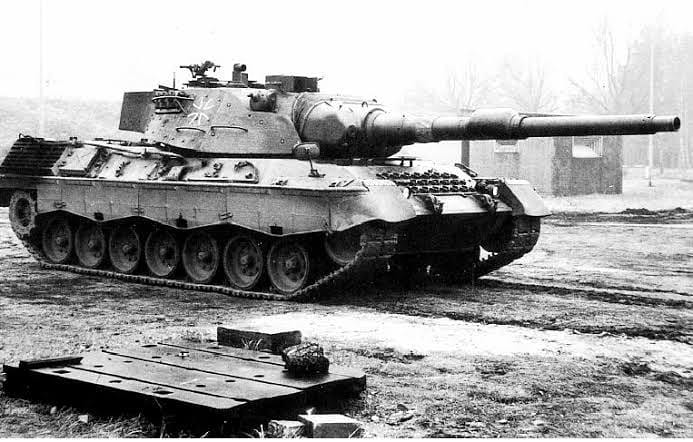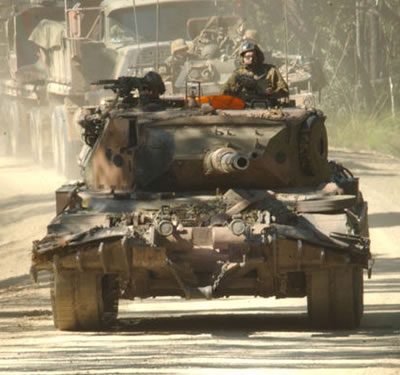
Last updated on February 19th, 2019 at 09:12 pm
The Leopard I main battle tank was the first tank produced by West Germany. For decades, it was used successfully by many countries.
After World War II ended, Germany was divided into two states, West Germany (the Federal Republic of Germany) and East Germany (the German Democratic Republic). West Germany was allied with the nations of the West, while East Germany was allied with the Soviet Union.
West Germany joined NATO in 1955 and then began to rebuild its military.
At first, the West German tank force consisted of M47 and M48 Patton medium tanks that were supplied by the United States.

However, the West Germans thought that these tanks were out of date, and wanted a newer, better tank.
West Germany began a program to develop its own tank, the Leopard, in 1956.
In 1957, France began working with West Germany to help design a common European tank, the Europa Panzer. Italy became a part of this collaborative effort in 1958.
Although prototypes of the Europa Panzer were developed, the project never got off the ground.
France and West Germany decided to make their own tanks, and Italy decided to purchase M60 Patton main battle tanks from the United States.
In 1963, West Germany awarded a production contract for the Leopard to the Krauss-Maffei company in Munich.
The first Leopard I main battle tanks were completed in 1965.
The West Germans prized speed and mobility over protection, so the Leopard I was lightly armored and fast, compared to American and British tanks of the time.
Armor on the Leopard I MBT has a maximum thickness of 2.76 inches (70mm). The Leopard I can move at a speed of up to 40mph (65kph).
The hull on the Leopard I is made of all-welded steel and the turret is made of all-cast steel armor.

There are seven pairs of road wheels and four track return rollers. The drive wheel is in the back and the idler is at the front.
A fully stabilized British 4.13 inch (105mm) L7A3 rifled gun is the Leopard I’s main weapon.
The Leopard I main battle tank also has a 0.3 inch (7.62 mm) coaxial machine gun and a 0.3 inch (7.62mm) anti-aircraft gun. There are four pairs of smoke grenade dischargers.
A four man crew operates the Leopard I. The driver sits at the front on the right. To his left are an NBC pack and some ammunition.
The commander and the gunner sit in the turret on the right, and the loader sits in the turret on the left.
The engine and the transmission are in the back of the tank.
The Leopard I MBT was exported to Italy, Canada, Norway, Denmark, Belgium, Greece, Turkey, Chile, Brazil, Australia and the Netherlands
Production of the Leopard I main battle tank ended in 1984 and the Leopard was phased out of service in Germany in 2003. However, it remains in service in some countries.
Italy built the Leopard I under license for a long time
The Leopard I main battle tank was upgraded many times, and many variants of the tank were produced.
Variants include an engineering vehicle, an armored recovery vehicle and a bridgelayer.
Some countries produced their own variants of the Leopard I.
The Leopard I main battle tank was used by Danish peacekeeping forces in Croatia and Bosnia in the 1990s.
Canada deployed Leopard I tanks in Afghanistan in 2006.
Leopard I Main Battle Tank |
|
|---|---|
| Active: | 1965 |
| Crew: | 4 |
| Weight: | 42 tons (42,400kg) |
| Length: | 23ft 3in (7.09m), 31 ft 3in (9.54m) with gun forwards |
| Height: | 9ft (2.76m) to top of commander’s periscope |
| Width: | 10ft 7in (3.25m) |
| Weapons: | Main – 4.13in (105mm) L7A3 rifled gun, Secondary – 1 x 0.3in (7.62mm) coaxial machine gun, 1 x 0.3 inch (7.62mm) anti-aircraft gun, 4 pairs of smoke grenade dischargerrs |
| Armor | Maximum – 2.76in (70mm) |
| Engine: | MTU MB 838 Ca M500 10-cylinder multi-fuel, 400hp |
| Speed: | 40mph (65kph) |
| Range: | 373 miles (600 km) |
